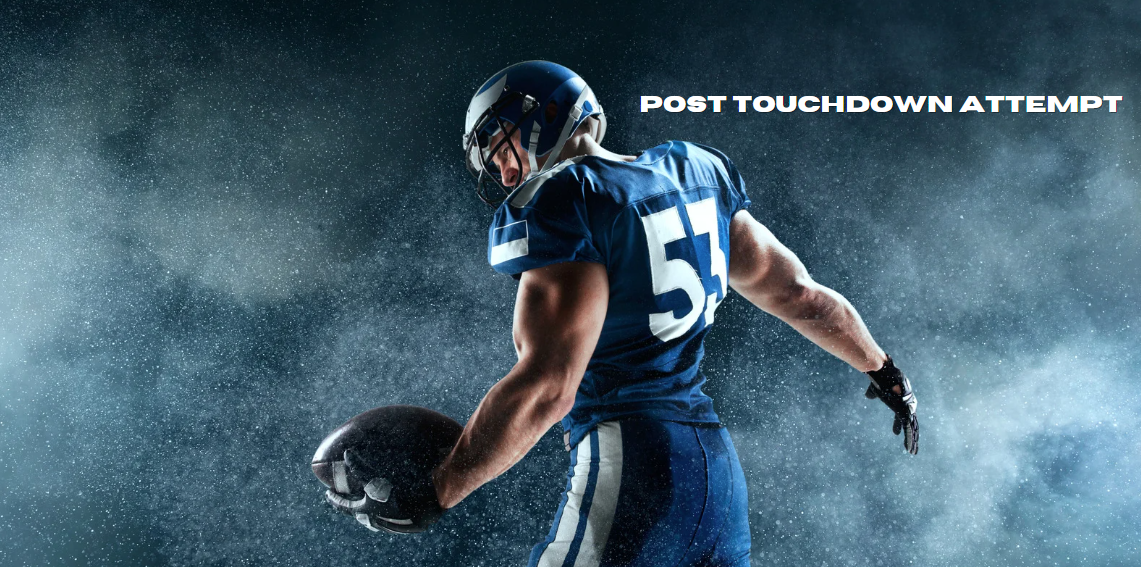Contents
- 1 Introduction
- 2 1. Understanding Post Touchdown Attempts
- 3 2. The Evolution of Post Touchdown Attempts
- 4 3. Extra Point Kicks: The Traditional Approach
- 5 4. Two-Point Conversion Attempts: A Risky Gamble
- 6 5. Strategic Considerations for Coaches
- 7 6. Impact of Rule Changes on Post Touchdown Attempts
- 8 7. Notable Post Touchdown Attempt Moments in NFL History
- 9 8. Post Touchdown Attempts in College Football
- 10 9. Statistical Analysis of Post Touchdown Attempts
- 11 10. The Psychological Aspect of Post Touchdown Attempts
- 12 11. FAQs About Post Touchdown Attempts
- 13 12. Conclusion
Introduction
In American football, the excitement doesn’t end with a touchdown. A crucial and often game-deciding phase follows, known as the post touchdown attempt. This phase includes extra point kicks and two-point conversion attempts, which can dramatically influence the game’s outcome.
This comprehensive guide delves into the intricacies of post touchdown attempts, offering in-depth insights, analyses, and expert interpretations.
1. Understanding Post Touchdown Attempts
A post touchdown attempt occurs immediately after a team scores a touchdown. The scoring team has two primary options: an extra point kick (worth one point) or a two-point conversion attempt (worth two points). The choice between these options depends on various factors, including game situation, team strengths, and coaching philosophy.
2. The Evolution of Post Touchdown Attempts
Early History
The concept of post touchdown attempts dates back to the early days of American football. Initially, the extra point kick was almost a guaranteed point, with success rates exceeding 99%. However, over time, the game’s dynamics evolved, making this phase more competitive and strategic.
Modern Changes
Recent rule changes, such as moving the extra point kick distance from the 2-yard line to the 15-yard line, have added an element of uncertainty. This adjustment has made extra point kicks more challenging, leading to a significant increase in the number of two-point conversion attempts.
3. Extra Point Kicks: The Traditional Approach
Mechanics of an Extra Point Kick
An extra point kick, also known as a PAT (Point After Touchdown), is executed from the 15-yard line, making it a 33-yard attempt. The kicker’s primary goal is to send the ball through the uprights of the goalpost. The snap, hold, and kick must be perfectly synchronized to ensure success.
Success Rates and Challenges
While extra point kicks are generally successful, the 2015 rule change has slightly reduced the success rate, adding a strategic element to the game. Weather conditions, kicker proficiency, and team pressure can all influence the outcome.
4. Two-Point Conversion Attempts: A Risky Gamble
Mechanics of a Two-Point Conversion
A two-point conversion attempt involves the offense trying to advance the ball into the end zone from the 2-yard line. This play can be a run or pass, and it requires precise execution and coordination.
Strategic Considerations
Coaches must weigh the risks and rewards when deciding to attempt a two-point conversion. Factors include the game’s current score, time remaining, and the team’s offensive capabilities. Successful two-point conversions can provide a significant advantage, but failure can shift momentum to the opposing team.
5. Strategic Considerations for Coaches
Game Situation
The decision to go for an extra point or a two-point conversion often depends on the game’s context. For example, trailing by one point late in the game might prompt a two-point attempt, while a comfortable lead might favor the safer extra point kick.
Team Strengths
Teams with strong offensive lines and versatile quarterbacks are more likely to attempt two-point conversions. Conversely, teams with reliable kickers might prefer the extra point.
Statistical Analysis
Data-driven analysis has become a crucial part of coaching decisions. Coaches often rely on advanced metrics to determine the most statistically advantageous option in various game scenarios.
6. Impact of Rule Changes on Post Touchdown Attempts
2015 Extra Point Rule Change
The 2015 rule change, moving the extra point attempt to the 15-yard line, has had a profound impact on the game. The increased difficulty of extra point kicks has led to more missed attempts and a higher frequency of two-point conversions.
Future Rule Changes
The NFL and NCAA continuously evaluate and adjust rules to enhance the game’s competitiveness and safety. Future changes could further influence post touchdown strategies and outcomes.
7. Notable Post Touchdown Attempt Moments in NFL History
The “Philly Special” (Super Bowl LII)
One of the most famous two-point conversions in NFL history, the “Philly Special,” was executed by the Philadelphia Eagles in Super Bowl LII. This trick play involved a direct snap to running back Corey Clement, who then handed the ball off to tight end Trey Burton, who threw a touchdown pass to quarterback Nick Foles.
Tom Dempsey’s Record Kick
Tom Dempsey, born without toes on his right foot, set an NFL record with a 63-yard field goal in 1970. His unique kicking style and remarkable achievement remain a significant part of NFL lore.
8. Post Touchdown Attempts in College Football
Differences from the NFL
While the basic principles of post touchdown attempts are the same in college football, there are notable differences. For instance, the distance for extra point kicks is shorter, and two-point conversions are more common due to the varied skill levels across teams.
Memorable College Moments
College football has seen its share of thrilling post touchdown attempts, such as the Boise State Broncos’ “Statue of Liberty” play in the 2007 Fiesta Bowl, which secured a two-point conversion and a stunning victory.
9. Statistical Analysis of Post Touchdown Attempts
Success Rates
Analyzing the success rates of extra point kicks and two-point conversions provides valuable insights into team strategies. Historically, extra point kicks have a higher success rate, but the gap has narrowed with recent rule changes.
Team Tendencies
Different teams exhibit distinct tendencies regarding post touchdown attempts. Some teams, like the Pittsburgh Steelers under Coach Mike Tomlin, are known for their aggressive two-point conversion strategies.
10. The Psychological Aspect of Post Touchdown Attempts
Pressure on Kickers
Kickers often face immense pressure during post touchdown attempts. The mental fortitude required to perform consistently under high-stress conditions is a critical aspect of a kicker’s success.
Team Morale
Successful post touchdown attempts can significantly boost a team’s morale, while failures can have the opposite effect. The psychological momentum gained or lost during this phase can influence the game’s outcome.
11. FAQs About Post Touchdown Attempts
What is a post touchdown attempt?
A post touchdown attempt is an opportunity for the scoring team to earn additional points immediately after scoring a touchdown, either through an extra point kick (worth one point) or a two-point conversion attempt (worth two points).
How far is the extra point kick in the NFL?
In the NFL, the extra point kick is attempted from the 15-yard line, making it a 33-yard attempt.
What factors influence the decision to go for a two-point conversion?
Coaches consider several factors, including the game’s current score, time remaining, team strengths, and statistical analysis, when deciding to attempt a two-point conversion.
Has the success rate of extra point kicks changed over time?
Yes, the success rate of extra point kicks has decreased slightly since the 2015 rule change that moved the attempt distance to the 15-yard line.
Can post touchdown attempts be blocked?
Yes, both extra point kicks and two-point conversion attempts can be blocked by the defending team.
12. Conclusion
Post touchdown attempts are a critical and thrilling aspect of American football, influencing game outcomes and adding strategic depth. Understanding the mechanics, history, and strategic considerations of these attempts provides a deeper appreciation for the game.
As the sport continues to evolve, the role of post touchdown attempts will undoubtedly remain a focal point for teams, coaches, and fans alike.
By providing detailed insights, historical context, and strategic analysis, this comprehensive guide aims to enhance your understanding of post touchdown attempts and their significance in American football.













































